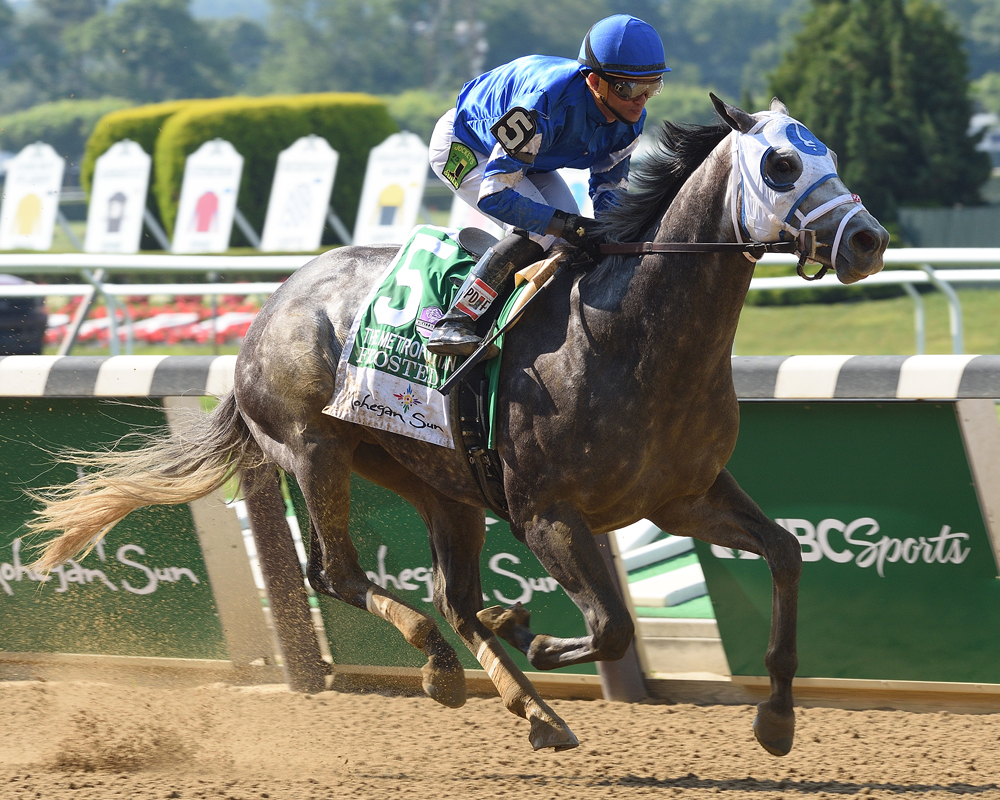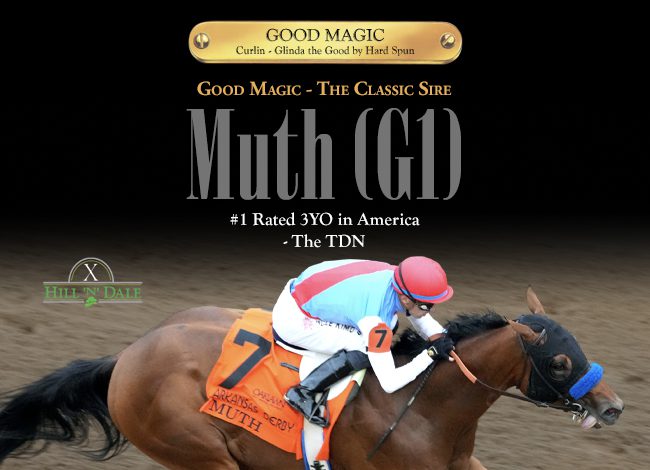By Andrew Caulfield
One of Europe's largest telecom companies used to declare that “the future is Orange.” Well, judging by events at Belmont Park three days ago, the future of the Thoroughbred could well be gray (or grey if–like me, you are in Europe).
As many as five of the 13 runners for the GI Belmont S. were described as grey or roan and Team Grey promptly monopolized the first three places, with Creator owing his victory over Destin and Lani partly to having horses with plenty of stamina as the sires of his first two dams. His game display came just two hours after the GI Metropolitan H., in which Frosted, another grey son of Tapit, had blitzed the opposition. Following Frosted home at a respectful distance was Anchor Down, yet another grey son of Tapit, and we also saw two greys fill the places behind the explosive Flintshire in the GI Woodford Reserve Manhattan S.
A former colleague of mine, Alan Yuill Walker, looked into the history of the gray/grey in a book called Grey Magic, published in 2005 by Highdown. The dust cover enticed readers by declaring that “Grey Magic is a unique book, because the grey Thoroughbred is a unique phenomenon, whose origins cannot fail to inspire any connoisseur of racing and breeding.
“It seems that everyone loves a grey racehorse. Not only is this the first publication of its kind devoted to famous greys over the last one hundred years, but it also reveals the astonishing truth that each and every one can trace his or her grey colour back to an Irish stallion foaled early in the nineteenth century.
“Remarkably all ninety-four of the famous horses featured in Grey Magic derive their grey coats from Master Robert, an otherwise relatively obscure racehorse. That this grey line of inheritance can be traced irrefutably to this particular source is due to two facts: firstly that any grey must have at least one grey parent; and secondly by virtue of the meticulous records of heredity maintained down the years by Messrs. Weatherbys, compilers and publishers of the General Stud Book.
“By far the greatest number of contemporary greys have The Tetrarch, a horse who might so well have been gelded as a youngster, as an essential link in the often precarious grey line of inheritance….”
Yuill Walker recorded that Master Robert, foaled in 1811, raced for three seasons and won ten times, mainly at the Curragh. Master Robert became the sire of Drone, the champion sire in Ireland in 1834, and Drone in turn became the principal son of Master Robert in perpetuating the grey coat colour. But what was the source of Master Robert's own grey coat? Yuill Walker found that Master Robert descended through an unbroken line of seven mares to the stallion Crab, bred in Lincolnshire in 1722. Crab became champion sire in 1748, '49 and '50 and apparently no grey stallion emulated him as champion sire until The Tetrarch in 1919. As I noted in my review of Marcel's pedigree in October last year, The Tetrarch unfortunately showed a marked lack of interest in sex and consequently sired only 130 foals, headed by the 2,000 Guineas winner Tetratema, who was to become champion sire, and that legendary filly Mumtaz Mahal.
This brings us neatly to Tapit, who owes his grey colour to the mares in the bottom line of his pedigree. His first four dams– Tap Your Heels, Ruby Slippers, Moon Glitter and Foggy Note– were all registered as grey or roan, but it is his fourth dam, Foggy Note, who supplies the links to some of the famous names mentioned above.
This tough mare, a winner of ten of her 34 starts, was the product of a mating between two greys (something not guaranteed to produce a grey). Her sire, The Axe, was by the Derby winner Mahmoud, who owed his grey colour to Mumtaz Mahal's daughter Mah Mahal.
Silver Song, the dam of Foggy Note, descended from a line of grey mares, namely Beadah, Beauty Spot, Spotted Beauty (who was registered as a strawberry roan) and Silver Beauty. Silver Beauty, in turn, was by Stefan The Great, a grey son of The Tetrarch. In other words, Foggy Note had two distant lines to The Tetrarch.
Tapit is clearly going to play a leading role in furthering the spread of greys, in much the same way that Unbridled's Song and El Prado have done. Of course not all of Tapit's stallion sons (or daughters) are eligible to pass on the grey gene, as Tonalist and Tapizar are bay and Trappe Shot and Tapiture are chesnut. However, there are also young grey sons of Tapit standing in Kentucky, New York, Maryland and Florida and there are surely more to come in the forms of Creator and Frosted. Other young possibilities include Cupid and Mohaymen.
Darley must be excited at the prospect of adding Frosted to its stallion team, just as WinStar must have high hopes of Creator (whose pedigree I reviewed following his Arkansas Derby success {click here}).
Weighted at 115 on the Experimental Free Handicap, Frosted has gone on to win the Wood Memorial at three and now the Met Mile at four, in addition to finishing second in the Belmont S. I also remember his gallant attempt to get the better of American Pharoah for the first time in the Travers S., which effectively passed victory to Keen Ice.
Frosted also has the attraction of being out of Fast Cookie, a tough and talented Deputy Minister mare who raced 31 times in four seasons, notably winning the GII Cotillion H. over 1 1/16 miles. Deputy Minister, of course, was a two-time champion sire who also became a champion sire of broodmares.
Fast Cookie is also a half-sister to a champion two-year-old colt in Midshipman, whose prospects as a stallion weren't helped by the remainder of his career being restrict to just two more starts in the U.S. and two in the United Arab Emirates. Even so, his 67-strong first crop has produced several stakes winners, led by that fast filly Lady Shipman.
Frosted will have a higher profile when he eventually retires. Breeders will probably like the fact that he is inbred 4 x 4 to the mighty Seattle Slew, with the second line coming via Fleet Lady, a dual GII-winning grand-daughter of the 1977 Triple Crown hero.
As I mentioned earlier, Tapit owes one of his grey lines to Mahmoud, winner of the 1936 Derby. This acts as a reminder that the future of the grey arguably looks less bright in Britain than in North America. No grey has managed to win Britain's premier classic since Airborne in 1946 and there has been no grey winner of the 2,000 Guineas since Mystiko in 1991. However, the Irish 2,000 Guineas winner Mastercraftsman is a grey, as are his St Leger-winning son Kingston Hill, who joined him on the Coolmore roster this year, and his Prix du Jockey-Club winner The Grey Gatsby.
The male line descending from Grey Sovereign–who owed his coat colour to a descendant of The Tetrarch–flourished for a long time, especially in France, and still has a few notable flag-bearers in France, led by Kendargent (plus another in the U.S. in Mizzen Mast).
I suspect, though, that if the greys are to flourish in Britain and Ireland it will be via Dark Angel, whose fee rose to €60,000 this year. This very good stallion–still only 11 years old–already has several grey stallion sons at stud, with the prospect of more to come from his higher-priced crops. His first four dams are grey, with the fourth dam Headland being a grand-daughter of Grey Sovereign, by Sovereign Path.
Not a subscriber? Click here to sign up for the daily PDF or alerts.






